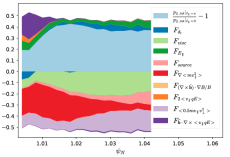Predicting Plasma Pressure in Future Fusion Facilities

Individual terms from the ion pressure balance. Many terms are important and sizeable besides the parallel pressure, including ion parallel viscous force, and terms resulting from particle drifts.
Scientific Achievement
Researchers at the U.S. Department of Energy’s (DOE) Princeton Plasma Physics Laboratory (PPPL) have developed new insights into the physics governing the balance of pressure in the scrape-off layer of fusion reactors.
Significance and Impact
A key requirement for future facilities that aim to capture and control on Earth the fusion energy that drives the sun and stars is accurate predictions of the pressure of the plasma — the hot, charged gas that fuels fusion reactions inside doughnut-shaped tokamaks that house the reactions. Central to these predictions is forecasting the pressure that the scrape-off layer, the thin strip of gas at the edge of the plasma, exerts on the divertor — the device that exhausts waste heat from fusion reactions.
Research Details
PPPL Physicist Michael Churchill and colleagues determined the key factors behind the pressure balance by running the state-of-the-art XGCa computer code on the Cori and Edison supercomputers The code treats plasma at a detailed kinetic — or particle motion— level rather than as a fluid. Among key features found was the impact of the bulk drift of ions, an impact that previous codes have largely ignored. Such drifts “can play an integral role” the authors wrote, and “are very important to take into account.”
The new findings could improve understanding of the scrape-off layer pressure at the divertor, Churchill said, and could lead to accurate forecasts for the international ITER experiment under construction in France and other next-generation tokamaks.
Additional Information
NERSC Resources Help PPPL Team Predict Plasma Pressure in Future Fusion Facilities
About NERSC and Berkeley Lab
The National Energy Research Scientific Computing Center (NERSC) is a U.S. Department of Energy Office of Science User Facility that serves as the primary high performance computing center for scientific research sponsored by the Office of Science. Located at Lawrence Berkeley National Laboratory, NERSC serves almost 10,000 scientists at national laboratories and universities researching a wide range of problems in climate, fusion energy, materials science, physics, chemistry, computational biology, and other disciplines. Berkeley Lab is a DOE national laboratory located in Berkeley, California. It conducts unclassified scientific research and is managed by the University of California for the U.S. Department of Energy. »Learn more about computing sciences at Berkeley Lab.







